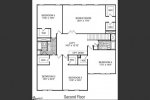Profile/Use Case
Power User, Reasonably Versed in Network, Work in IT
AMD Ryzen 9 3950X/ 16GB RAM, 1080TI,.Crosshair VIII Mobo
Main Use Case, Adobe Premiere, Photoshop, Illustrator, Moving Large files over network to NAS (SSD Arrays), Gaming.
Connected PC's backup to NAS Nightly
SmartTv's in house connect to a Plex Server
Current Network
Linksys EA9500 Main Router & WIFI
DLINK 24Port Switch
Self Run Cat 6 Hardwire to Every Room
ISP Bandwidth 1GB Down/30 Up
Assume All desktops are hardwired
All Laptops are Wireless
All Cameras are Wireless
Home 4,100 Sq/ft 2 Story Drywall
Network Architecture
ISP Modem > EA9500 Router > DLink Managed Switch > All rooms connect to switch > All Desktop PC's connect to switch
Devices:
4 Iphone 10 (2.4/5ghz)
3 PS4 Pros
1 Nintendo Switch
4 Laptops (2.4/5ghz)
4 Desktops PC (Wired)
1 Dell Pro Server (NAS)
5 Security Cameras (1080p (2.4)ghz)
1 Door Bell (Wirelss 2.4)
5 Firestick HD
5 Smart TV
3 iPads
15 Misc Wifi connected devices (Security System, SmartWatchies, EACO Dots, Alexa's, Outdoor Wifi Landscape Lighting, 2 Cars, Saltwater Aquarium Equipment)
Current Problems:
Slow WIFI Video Cameras, SLOW Wifi/WiFi Dropouts on Phones, Temporary WiFi Loss at Misc Wifi Devices
I'm hoping to get suggestions of a proven Mesh Wifi System, or Router + WIRED Access Point System to replace the EA9500 which hasn't ever received a firmware upgrade and still has USB3 ports that are useless.
I have already
Re-Positioned the Router
Tried to Balance all the devices on the 2 5ghz Bands (Range makes this hard)
Scanned and Tried to choose less used Channels than Neighbors
Disabled QOS
Disabled BandSteering
I THINK I need something like a good AC router (Triband) with 2 Triband Access Points)
I thought of using
Option #1
Ubiquiti Networks - ER-12P - Main Router/DHCP (I do not want to hardware offload)
> Connected to DLINK switch (Existing) or Ubiquiti EdgeSwitch Lite 24 Ports Wall-Mountable Fanless Switch with Optional DC Input - ES-24-LITE-US
>>Connected to 4X Ubiquiti UNIFI AP AC LONG RANGE (2 Upstairs 2 Downstairs Hardwired)
Option #2
4X Google Nest WIFI - Routers Hardwired
Option #3
Netgear Orbi
I did not want to go with AiMesh because in my research I found that they take one of the 5ghz and force it as a backhaul even when wired
Power User, Reasonably Versed in Network, Work in IT
AMD Ryzen 9 3950X/ 16GB RAM, 1080TI,.Crosshair VIII Mobo
Main Use Case, Adobe Premiere, Photoshop, Illustrator, Moving Large files over network to NAS (SSD Arrays), Gaming.
Connected PC's backup to NAS Nightly
SmartTv's in house connect to a Plex Server
Current Network
Linksys EA9500 Main Router & WIFI
DLINK 24Port Switch
Self Run Cat 6 Hardwire to Every Room
ISP Bandwidth 1GB Down/30 Up
Assume All desktops are hardwired
All Laptops are Wireless
All Cameras are Wireless
Home 4,100 Sq/ft 2 Story Drywall
Network Architecture
ISP Modem > EA9500 Router > DLink Managed Switch > All rooms connect to switch > All Desktop PC's connect to switch
Devices:
4 Iphone 10 (2.4/5ghz)
3 PS4 Pros
1 Nintendo Switch
4 Laptops (2.4/5ghz)
4 Desktops PC (Wired)
1 Dell Pro Server (NAS)
5 Security Cameras (1080p (2.4)ghz)
1 Door Bell (Wirelss 2.4)
5 Firestick HD
5 Smart TV
3 iPads
15 Misc Wifi connected devices (Security System, SmartWatchies, EACO Dots, Alexa's, Outdoor Wifi Landscape Lighting, 2 Cars, Saltwater Aquarium Equipment)
Current Problems:
Slow WIFI Video Cameras, SLOW Wifi/WiFi Dropouts on Phones, Temporary WiFi Loss at Misc Wifi Devices
I'm hoping to get suggestions of a proven Mesh Wifi System, or Router + WIRED Access Point System to replace the EA9500 which hasn't ever received a firmware upgrade and still has USB3 ports that are useless.
I have already
Re-Positioned the Router
Tried to Balance all the devices on the 2 5ghz Bands (Range makes this hard)
Scanned and Tried to choose less used Channels than Neighbors
Disabled QOS
Disabled BandSteering
I THINK I need something like a good AC router (Triband) with 2 Triband Access Points)
I thought of using
Option #1
Ubiquiti Networks - ER-12P - Main Router/DHCP (I do not want to hardware offload)
> Connected to DLINK switch (Existing) or Ubiquiti EdgeSwitch Lite 24 Ports Wall-Mountable Fanless Switch with Optional DC Input - ES-24-LITE-US
>>Connected to 4X Ubiquiti UNIFI AP AC LONG RANGE (2 Upstairs 2 Downstairs Hardwired)
Option #2
4X Google Nest WIFI - Routers Hardwired
Option #3
Netgear Orbi
I did not want to go with AiMesh because in my research I found that they take one of the 5ghz and force it as a backhaul even when wired













